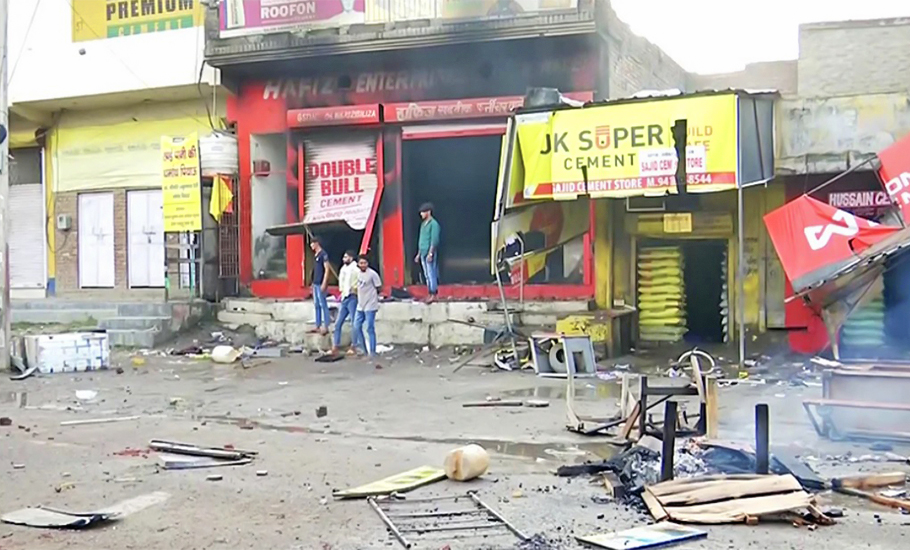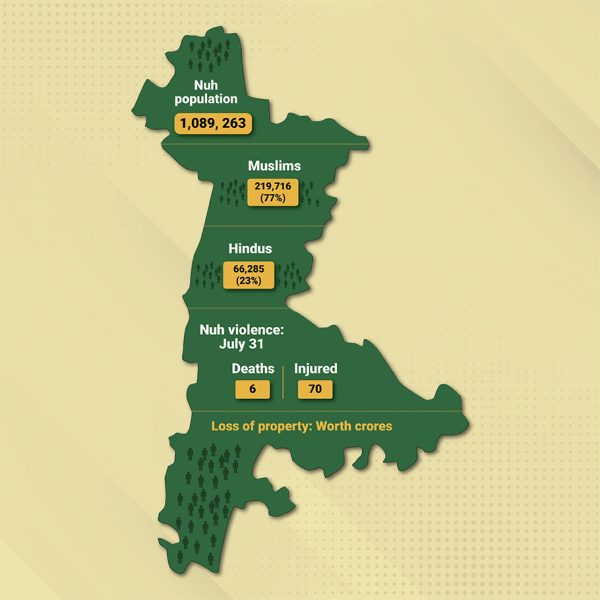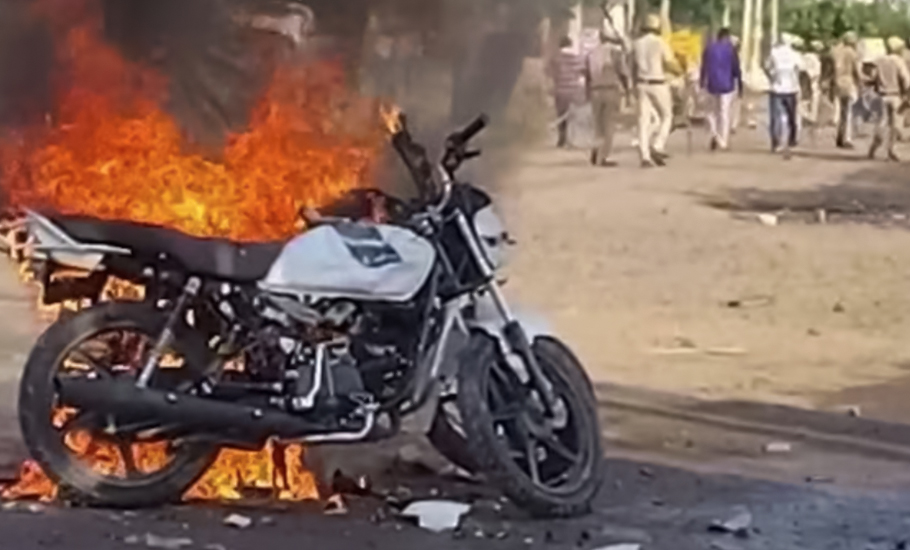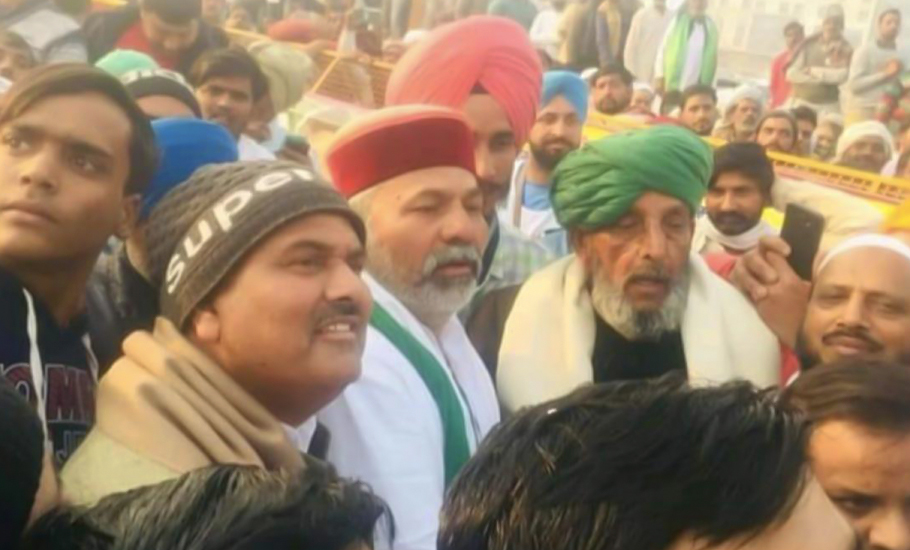
- Home
- News
- Analysis
- States
- Perspective
- Videos
- Education
- Entertainment
- Elections
- World Cup 2023
- Features
- Health
- Budget 2024-25
- Business
- Series
- NEET TANGLE
- Economy Series
- Earth Day
- Kashmir’s Frozen Turbulence
- India@75
- The legend of Ramjanmabhoomi
- Liberalisation@30
- How to tame a dragon
- Celebrating biodiversity
- Farm Matters
- 50 days of solitude
- Bringing Migrants Home
- Budget 2020
- Jharkhand Votes
- The Federal Investigates
- The Federal Impact
- Vanishing Sand
- Gandhi @ 150
- Andhra Today
- Field report
- Operation Gulmarg
- Pandemic @1 Mn in India
- The Federal Year-End
- The Zero Year
- Premium
- Science
- Brand studio
- Home
- NewsNews
- Analysis
- StatesStates
- PerspectivePerspective
- VideosVideos
- Entertainment
- ElectionsElections
- Sports
- Loading...
Sports - Features
- Budget 2024-25
- BusinessBusiness
- Premium
- Loading...
Premium

Why Jats in Haryana are turning away Hindutva forces in Nuh

Nuh, one of 22 districts of the northern state of Haryana, is edgy, sporting a tense calm. After days of violence, which started on July 31, leaving 6 dead and about 70 others injured, Haryana’s most-underdeveloped district knows the trust between Hindus and Muslims will be hard to restore. With two home guards, an imam at a mosque and a Bajrang Dal member among those who died, both sides...
Nuh, one of 22 districts of the northern state of Haryana, is edgy, sporting a tense calm. After days of violence, which started on July 31, leaving 6 dead and about 70 others injured, Haryana’s most-underdeveloped district knows the trust between Hindus and Muslims will be hard to restore. With two home guards, an imam at a mosque and a Bajrang Dal member among those who died, both sides have lost property, people and mutual trust.
With a population of nearly 11 lakh people, 77 per cent of whom are Meo Muslims, Nuh saw an array of provocative speeches and videos ahead of the Brij Mandal Jalabhishek Yatra, a procession organised by the Bajrang Dal and the Vishwa Hindu Parishad (VHP), on July 31.
The immediate trigger of the violence in Nuh, reports suggest, may have been a video posted by Mohit Yadav alias Monu Manesar, the cow vigilante who is wanted for the alleged murder of two Muslim men in February. In the video, shared on Facebook on July 30, Manesar urged Hindus to participate in the Brij Mandal Jalabhishek Yatra in Nuh’s Mewat town, declaring he himself would join the procession, despite being a wanted man. Soon after, another cow vigilante, Bittu Bajrangi, also uploaded a series of videos announcing his arrival in Mewat.

While the clashes that followed are being dubbed as Hindu-Muslim riots, a video that emerged on August 2 shows a section of Hindus, comprising Jats, distancing themselves from the larger saffron fold which participated in the violence burning mosques and destroying property.
Refusing to accept that the July 31 violent episode in Nuh is an attack on their religion, Om Prakash Dhankhar, head of Dhankhar Khap, which exercises influence over 60-70 villages in the region, released a video with an appeal to the Jat youths to stay out of the conflict.
“In 1987, I worked in the Mewat area as an agriculture department officer. The then Devi Lal government had given us the task to ensure old-age pension for the local population of the region. During the exercise of scanning the documents of the Muslims, we were surprised to find that the names of their fathers and grandfathers were the same as ours. We could not spot any difference in names of older people in Mewat, a Muslim dominated area and other areas dominated by Hindus,” the khap leader told The Federal, explaining the reason for his appeal to Jat youth.

He cautioned the youth, especially those in rural areas, to not get swayed by the appeals being made on social media by saffron outfits such as Bajrang Dal or VHP, to join them in fighting the Muslims.
Interestingly, the Jat community is finding itself closer to the Muslim community than their Hindu counterparts.
“Mewat area is dominated by the farming community which is constituted by hard-working people, like the rest of Haryana. Their physique, lifestyle, and attitude toward life are the same as ours. In fact, their religion was also the same before they were converted in the Mughal era. In a way, we share our ancestry and DNA with the Muslims of Mewat,” Prakash Dhankhar said.
He underlined that this wasn’t a cause of the Jats, who have already suffered a lot over the last eight years of BJP rule in the state.
The seeds of Jat discord, however, seem to have been sown during the farmers’ agitation against the farm laws.
Kisan Andolan activists carry past hurt
Suresh Koth, a Jat leader who played a key role during the 13-month-long farmers’ agitation on the outskirts of Delhi, said that anyone who believes in the ideology of peasant leader Chhotu Ram would not participate in any kind of movement post Nuh violence.
“Chhotu Ram, who is revered as a messiah by the agrarian community, once said that innocent farmers should learn to differentiate between friends and foes. This is the time to make the right judgment and show Jat allegiance with those who supported the farmers’ agitation, not the one who called farmers names,” said Koth, who hails from the Jind-Kaithal area.
Jats make up above 30 per cent of that population in Haryana but have remained a dominant force socially and politically since the state’s formation in 1966.

The long-standing Jat-Muslim brotherhood had suffered a jolt in 2013, in Muzaffarnagar and Shamli districts in Western Uttar Pradesh. Fearing violence from the dominant Jat community of Kutba-Kutbi village, about 24 kms from the district headquarters of Muzaffarnagar, the 500-odd Muslim residents fled after the August-September 2013 communal riots which claimed the lives of about 60 from both Hindu and Muslim communities.
But that bond was rebuilt during the farmers’ agitation. Koth said that during the farmers’ agitation, saffron outfits were quick to dub farmers as ‘Khalistani’ at a time when farmers of Mewat set up their tents along with them to express solidarity.
“It was these saffron outfits that first created an environment where they used objectionable language against the Muslim community before the procession day. They actually wanted to disturb the harmony of Mewat and brotherhood of all communities by issuing such statements,” he alleged.
Anger against the BJP government
Dharmender Hooda, one of the prominent youth faces that emerged during the 2016 Jat agitation, was the first one to come forward post the July 31 Nuh violence.
Appealing to the youths of the village, Hooda said that during the 2016 agitation for reservation, youths from the Jat community suffered the most. “Most of those who face police FIRs, criminal charges and legal cases in court were from Jat community. Our only fault was only that we had stood for our rights,” he said.
On July 31, Hooda alleged that the current circumstances are similar to the what existed at the time of the reservation agitation. “There are several instances when Jats suffered the most and were vilified for standing for the cause. The first one was the reservation issue of 2016. BJP sympathisers built the Jat versus non-Jat narrative at that time. The 2013 Muzzafarnagar episode in Uttar Pradesh showed the seeds of enmity between Jats and Muslims. Earlier, Jats and Muslims lived as brothers. The women wrestlers’ agitation at Jantar Mantar was also countered with a smear campaign by the same people. The whole community was called names and online trolling campaigns were run against the Jats. Standing for our rights in a democratic manner was projected as our fault,” he alleged.
The Jat leader says that the saffron outfits want to extract political benefit out of the Nuh incident and for that they want to rope in youths from the Jat community. “We will not let that happen and become fodder for anyone’s political interests,” he added.
The Jat support for Muslims was also seen on July 3 when a saffron outfit was forced to retract its statement in which they threatened poor Muslims who engage in small jobs in city to leave Hansi of Hisar district within two days or face consequences.
Within hours of their protest march, farmers of Hansi held a march in which they appealed to Muslims to not be afraid as the Jats would stand by them if the need arises. Hansi SP Maqsood Ahmed said that a case was registered against Krishna Gurjar of Bajrang Dal and others for rioting, unlawful assembly and giving provocation, promoting enmity and criminal intimidation.
Sensing the gravity of the situation, Haryana khaps and farm unions assembled in Jind on July 5 and gave a call for religious unity.
Azad Pahlwa, a Jind-based farmer unionist, said that they passed a resolution calling for unity between members of all religions and ban on right-wing outfits. The farm union also accused BJP and Rashtriya Swayamsevak Sangh (RSS) of playing the politics of divide and rule. The unionist also announced to pay a visit to violence affected Nuh area in the near future to express solidarity with Muslims.
While Hooda is a BJP opponent, similar sentiments have been echoed by BJP’s ally as well.
Deputy chief minister Dushyant Chautala, whose Jannayak Janta Party (JJP) formed an alliance with BJP Haryana in 2019 to prove majority in a House of 90 seats, questioned whether those who call themselves cow vigilantes should be probed for how many cows they actually rear at their homes.
“This is a serious question that needs to be ascertained. They call themselves ‘gau rakshaks’ but how many of them actually rear cows at their homes? This background check would clear many things about those who profess themselves as cow vigilantes,” Chautala, who is one of the prominent Jat faces in Haryana, said.
His party JJP won 10 seats and the majority of these assembly segments are dominated by Jat community. Seeking a thorough probe into the Nuh episode, Chautala asked how communal clashes happened in Nuh, when the region was peaceful over 600 years.
Social media, meanwhile, could have played a huge role in widening the gulf between Jats and Hindus.
Naveen Raman, a political analyst based in Chandigarh, said that some Jats in the recent past declared on their social media profiles that they are Jats, not Hindus, triggering massive trolling by saffron outfits. They were called anti-Hindu forces.
Raman said that the reality is that post the 2016 reservation agitation, in which many Jat youths were booked and faced legal cases, they stay away from violent activities. “Though they were part of the farmers’ protest, they retracted their support after the Red Fort violence on Republic Day in 2021. The Jat intelligentsia can see through the ploy of Nuh is being used politically. In the assembly election, the saffron brigade will play Jat versus non-Jat politics to win the elections,” he added.

Satish Tyagi, who has penned a popular book on Haryana politics Politics of Chaudhar, said that not only Jats, no caste organisation wants to be part of any violence. “Jats suffered humiliation, police cases, court battles post the 2016 reservation protests. Farmers, who comprise Jats, Brahmins, Yadav, Gujjars, have no interest in saffron outfits’ call to boycott Muslims of Mewat as their economic condition has worsened in the last eight years of incumbent regime,” he said.
Tyagi said unlike Uttar Pradesh, Haryana never witnessed any communal clash before 2014, and people have started realising it more after experiencing the turn of events and its outcomes in the last several years.

